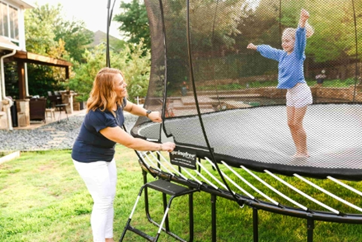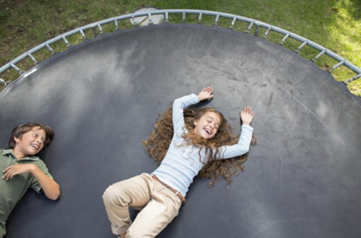Jumping on a trampoline is a fun and exhilarating activity enjoyed by people of all ages. However, like any physical activity, trampolining can carry injury risks if proper safety measures aren’t in place. If you’re wondering if are trampolines safe, it’s essential to ensure that yours is set up correctly and maintained properly to avoid accidents. This comprehensive guide will help you understand the various factors that affect trampoline safety, from the equipment you choose to the safety practices you follow. Whether for children or adults, these guidelines will ensure a safe and enjoyable trampolining experience, allowing you to have fun without worry.

What Makes Trampolines Safe or Dangerous?
The safety of a trampoline largely depends on several factors, including its construction, maintenance, and usage. A trampoline with safety features like a secure enclosure net and protective padding can mitigate many common risks. On the other hand, trampolines without proper safety measures or poorly maintained equipment can be hazardous. A lack of regular inspections for wear and tear, or improper setup, can lead to accidents like falls or entrapments. Additionally, improper usage, such as excessive bouncing or jumping with multiple people, increases the chances of injury. Ensuring that your trampoline meets safety standards and is regularly maintained can significantly reduce the danger involved.
Are Trampolines Safe for Kids?
Trampolines can be safe for children when proper safety measures are in place. Children, in particular, need supervision while using trampolines to avoid accidents. Always ensure the trampoline has essential safety features, such as a sturdy enclosure net that prevents falls. The trampoline should also be age-appropriate, as smaller children may be at a higher risk of injury due to their lack of coordination. It's crucial to limit the number of children jumping at one time to avoid collisions, which can lead to injuries. By setting clear rules, such as no flips and no roughhousing, and enforcing supervision, parents can help keep their kids safe while using the trampoline.
Trampoline Safety for Adults
While adults generally have better control and balance than children, trampoline safety is still important. Adult trampoline users must also follow safety guidelines to avoid injuries such as sprains, fractures, or back injuries. It's essential to warm up before jumping to avoid straining muscles and joints. Additionally, adults should avoid risky maneuvers, such as flips or twists, unless properly trained. Just like with children, adults should ensure the trampoline is in good condition and that safety nets and padding are intact. Using trampolines safely and following the manufacturer’s instructions ensures that adults can enjoy a fun and injury-free experience on the trampoline.
Essential Trampoline Safety Guidelines for All Ages
Setting Up Your Trampoline Correctly
Proper setup is the first step in ensuring the safety of a trampoline. Place the trampoline on a level, soft surface, like grass, to minimize the impact of falls. Avoid setting it up on concrete or hard surfaces, as this increases the risk of injury. The area surrounding the trampoline should be free of obstacles such as trees, fences, or hard objects that could pose a danger if someone falls. Additionally, make sure the trampoline is securely anchored to prevent tipping or movement. When setting up, ensure that all components are correctly assembled according to the manufacturer’s instructions. Proper setup is key to minimizing risk and ensuring a safe jumping environment.
Using Safety Features: Nets, Pads, and Enclosures
Safety features like nets, pads, and enclosures play a crucial role in trampoline safety. Safety nets prevent users from falling off the trampoline, reducing the risk of serious injuries. The padding around the trampoline’s frame and springs cushions falls and helps protect against injuries caused by sharp metal or exposed parts. Enclosures should be securely fastened to prevent gaps and ensure they are high enough to keep users from accidentally falling off. Regularly check these features for wear and tear, as damaged nets or pads may not offer the necessary protection. Investing in a trampoline with these safety features is essential for minimizing injury risks.

Safe Jumping Practices for All Users
Safe jumping practices are critical in reducing trampoline injuries. Start with simple, controlled jumps and avoid attempting complex moves, such as flips and somersaults, unless trained. Jumping with only one person at a time is essential to prevent collisions, which are a leading cause of injury. Establish clear guidelines for trampoline use, such as no roughhousing, no pushing, and no jumping off the trampoline. Ensure that users are aware of the proper techniques, like landing on the center of the trampoline and using the proper form. Proper training and adherence to these safe practices can greatly reduce the likelihood of accidents and injuries while using the trampoline.
Supervision and Rules for Safe Usage
Supervision is essential when it comes to trampoline safety, especially for children. Adults should always oversee trampoline use to ensure that users follow safety rules. Set clear and consistent rules such as no flips, no rough play, and no more than one person jumping at a time. Use a ladder to get on and off the trampoline safely, and ensure that children understand the importance of following these rules. Without supervision, children may engage in risky behavior that can lead to injury. By enforcing these rules and providing supervision, you create a safer environment and help ensure that trampolining remains a fun and safe activity.
Common Trampoline Injuries and How to Prevent Them
Common trampoline injuries include sprains, fractures, and head injuries, typically caused by improper landings, falls off the trampoline, or collisions. To prevent these injuries, it's important to follow safety guidelines such as using proper jumping techniques, avoiding risky maneuvers, and so on. Safety nets and padding can greatly reduce the severity of injuries caused by falls, while proper setup and maintenance can prevent accidents caused by equipment failure. Regularly inspecting the trampoline for wear and tear, and replacing damaged parts promptly, can also reduce the risk of injury and ensure that the trampoline remains safe for use.
How to Make Your Trampoline Safer
To further enhance trampoline safety, it's essential to regularly inspect the trampoline for any signs of wear and tear. Look for any frayed or torn nets, damaged springs, or worn-out pads. If any parts are damaged, they should be replaced immediately to ensure that the trampoline remains safe for use. Using weather covers can help protect the trampoline from the elements and extend its lifespan. Before each use, ensure that the jumping surface is clean and dry to prevent slipping. Taking these proactive maintenance steps and keeping the trampoline in top condition will greatly reduce the risk of accidents and injuries.
Conclusion
Trampolines can be an enjoyable and safe activity when the proper precautions are taken. If you’re considering whether are trampolines safe for your family, understanding the factors that contribute to trampoline safety, following essential guidelines, and staying vigilant during is are key to reducing risks. By setting up your trampoline correctly, using the right safety features, and maintaining good supervision, you can ensure that the trampoline remains fun and injury-free. Regular maintenance, proper jumping techniques, and enforcing safety rules will help create a secure environment for users of all ages. Prioritizing safety will allow you to fully enjoy your trampoline, making it a great addition to your outdoor activities.
FAQ:
Are trampolines safe for toddlers?
Trampolines are generally not recommended for toddlers due to their high injury risk. If used, they must be under strict supervision with additional safety precautions such as specialized toddler trampolines with low heights and additional padding.
How can I reduce the risk of injury on a trampoline?
To reduce injury risk, always use safety nets and pads, supervise users, enforce safe jumping practices, limit the trampoline to one person at a time, and regularly inspect and maintain the trampoline.
What are the best trampolines for safety?
The best trampolines for safety include models with sturdy frames, high-quality nets and padding, and those that meet safety certifications. Brands like Springfree and Vuly offer trampolines designed with enhanced safety features for added protection.
